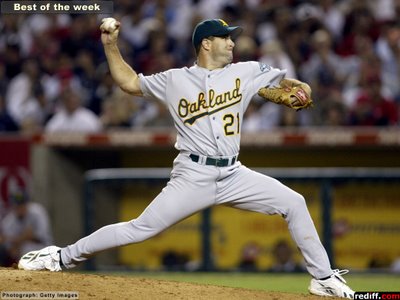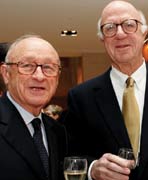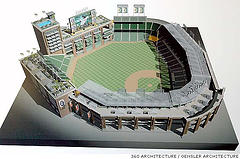 This is shocking, and serves to remind us all of how precious life really is. Our prayers go out to the Lildle family and friends.
This is shocking, and serves to remind us all of how precious life really is. Our prayers go out to the Lildle family and friends. Lidle dies as plane crashes into Manhattan high-rise
ESPN.com news services
NEW YORK -- A small plane with New York Yankees pitcher Cory Lidle aboard crashed into a 50-story condominium tower Wednesday on Manhattan's Upper East Side, killing at least two people -- including Lidle -- and raining flaming debris on sidewalks, authorities said.
Athletes Who Died In Plane Crashes
• Oct. 18, 1925 -- Marvin Goodwin, Cincinnati Reds pitcher, in Houston.
• March 31, 1931 -- Knute Rockne, Notre Dame football coach, in Kansas
• May 4, 1949 -- 22 members of Torino, the Italian soccer champions, in Turin, Italy.
• Oct. 27, 1949 -- Marcel Cerdan, former world middleweight champion, en route to fight Jake LaMotta in Spain.
• July 1, 1954 -- John McBride, Alabama halfback, killed in ROTC training flight in Texas.
• Oct. 30, 1954 -- Wilbur Shaw, President of Indianapolis Motor Speedway, in Decatur, Ind.
• Sept. 20, 1956 -- Tom Gastall, Baltimore Orioles catcher, in Maryland.
• Nov. 27, 1956 -- Charlie Peete, St. Louis Cardinal outfielder, in Venezuela.
• Feb. 6, 1958 -- Eight members of the English soccer champion Manchester United, in Munich.
• Aug. 14, 1958 -- Six members of the Egyptian fencing team, in the Atlantic Ocean.
• Oct. 30, 1958 -- Philip Scrutton, British Walker Cup golfer.
• April 29, 1959 -- Joaquin Blume, Spain's European gymnastics champion, in Madrid.
• Oct. 10, 1960 -- 16 members of the Cal Poly San Luis Obispo football team, in Toledo, Ohio.
• Feb. 16, 1961 -- 18 members of the U.S. figure skating team, in Belgium.
• April 3, 1961 -- Green Cross, a first-division Chilean soccer team, in the Las Lastimas Mountains.
• March 1, 1962 -- Johnny Dieckman, world fly-casting champion, in Chicago.
• April 12, 1962 -- Ron Flockhart, Scottish racing driver, in Melbourne.
• Feb. 15, 1964 -- Ken Hubbs, 22, Chicago Cub second baseman, in Utah.
• July 24, 1966 -- Tony Lema, 1964 British Open champion, in Munster, Ind.
• April 28, 1968 -- Six members of the Lamar Tech track team, in Beaumont, Texas.
• Sept. 26, 1969 -- 25 members of Bolivian soccer team "The Strongest", in the Andes.
• Oct. 2, 1970 -- 14 Wichita State football players, in Colorado.
• Nov. 14, 1970 -- 36 Marshall University football players, in Huntington, W.Va.
• Oct. 11, 1972 -- 30 members of a Uruguayan rugby club, in Chile.
• Dec. 31, 1972 -- Roberto Clemente, Pittsburgh Pirate outfielder, from San Juan, Puerto Rico en route to Nicaragua to aid earthquake victims.
• June 24, 1975 -- Wendell Ladner, New York Nets forward, in New York.
• Dec. 13, 1977 -- 14 University of Evansville basketball players and coach Bobby Watson in Evansville, Ind.
• Aug. 2, 1979 -- Thurman Munson, New York Yankees catcher, in Canton, Ohio.
• Jan. 11, 1980 -- Bo Rein, LSU football coach, in the Atlantic Ocean.
• March 14, 1980 -- 14 members of the U.S. amateur boxing team in Warsaw, Poland.
• Dec. 12, 1983 -- Rex Dockery, Memphis State football coach, with offensive coordinator Chris Faros and defensive back Charles Greenhill, Lawrenceburg, Tenn.
• Nov. 25, 1985 -- Six members of the Iowa State women's cross country team in Des Moines, Iowa.
• Aug. 16, 1987 -- Nick Vanos, Phoenix Suns center, in Romulus, Mich.
• Dec. 8, 1987 -- 17 players of the Alianza Peruvian first-division soccer team in Lima, Peru.
• Sept. 30, 1988 -- Al Holbert, six-time IMSA champion, near Columbus Ohio.
• July 19, 1989 -- Jay Ramsdell, CBA Commissioner, in Sioux City, Iowa.
• April 1, 1993 -- Alan Kulwicki, NASCAR's 1992 champion, in Blountville, Tenn.
• April 28, 1993 -- 18 players and five team officials of Zambia's national soccer team in Libreville, Gabon.
• July 13, 1993 -- Davey Allison, NASCAR driver, the day after a helicopter he was piloting crashed on the infield at Talladega Superspeedway in Talladega, Ala.
• April 18, 1996 -- Brook Berringer, Nebraska quarterback, two days before the NFL draft, when the small plane he was piloting crashed in Raymond, Neb.
• May 11, 1996 -- Rodney Culver, San Diego Chargers running back, in Florida Everglades.
• Oct. 25, 1999 -- Payne Stewart, winner of the 1989 PGA Championship and a two-time U.S. Open winner, two miles west of Mina, S.D.
• Jan. 27, 2001 -- Oklahoma State basketball players Dan Lawson and Nate Fleming, and six team staffers and broadcasters, in Byers, Colo.
-- Associated Press
Federal Aviation Administration records showed the single-engine plane was registered to Lidle. A law enforcement official in Washington, speaking on condition on anonymity, said two people were aboard, and Lidle's passport was found at the crash scene. The plane had issued a distress call before the crash, according to the official.
Mayor Michael Bloomberg said both people aboard were killed.
On Sunday, the day after the Yankees were eliminated from the playoffs, Lidle cleaned out his locker at Yankee Stadium and talked about his interest in flying.
He explained to reporters the process of getting a pilot's license and said he intended to fly back to California in several days and planned to make a few stops. Lidle discussed the plane crash of John F. Kennedy Jr. and how he had read the accident report on the National Transportation Safety Board Web site.
Lidle, acquired from the Philadelphia Phillies on July 30, told The New York Times last month that his four-seat Cirrus SR20 plane was safe.
"The whole plane has a parachute [that can be deployed in the event of emergency] on it," Lidle said. "Ninety-nine percent of pilots that go up never have engine failure, and the 1 percent that do usually land it. But if you're up in the air and something goes wrong, you pull that parachute, and the whole plane goes down slowly."
Lidle also talked about airplanes' safety in an interview with MLB.com in February.
"If you're 7,000 feet in the air and your engine stops, you can glide for 20 minutes," Lidle said at the time. "As long as you're careful, everything should be fine."
Lidle pitched 1 1/3 innings in the fourth and final game of the AL Division Series against the Detroit Tigers and gave up three earned runs but was not the losing pitcher. He had a 12-10 regular-season record with a 4.85 ERA.
He pitched with the Phillies before coming to the Yankees, who acquired him at the July trade deadline along with outfielder Bobby Abreu. He began his career in 1997 with the Mets. He also pitched for Tampa Bay, Oakland, Toronto and Cincinnati.
Lidle was an outcast among some teammates throughout his career because he became a replacement player in 1995, when major-leaguers were on strike.
For his career, he was 82-72 with two saves and a 4.57 ERA.
"I wish I had the words. I have no words. I just have strong emotions, it's sadder than sad," Mets pitching coach Rick Peterson, who was Lidle's pitching with the A's from 2001-02, told ESPN.com's Jayson Stark. "I wish I had an answer [about how to prepare for a baseball game under these circumstances]. I don't have an answer. You try to deal with the emotions first. It's horrific, it's unbelievable, just a surreal moment. It just shows how insignificant some of the things we think are significant really are."
The twin-engine plane came through a hazy, cloudy sky and hit the 20th floor of The Belaire -- a red-brick tower overlooking the East River, about five miles from the World Trade Center -- with a loud bang, touching off a raging fire that cast a pillar of black smoke over the city and sent flames shooting from four windows on two adjoining floors.
Large crowds gathered in the street in the largely wealthy New York neighborhood, with many people in tears and some trying to reach loved ones by cell phone.
"I was worried the building would explode, so I got out of there fast," said Lori Claymont, who fled an adjoining building in sweatpants.
Young May Cha, a 23-year-old Cornell University medical student, said she was walking back from the grocery store down 72nd Street when she saw an object out of the corner of her eye.
"I just saw something come across the sky and crash into that building," she said. Cha said there appeared to be smoke coming from behind the aircraft, and "it looked like it was flying erraticaly for the short time that I saw it."
"The explosion was very small. I was not threatened for my life," she added.
Richard Drutman, a professional photographer who lives on the 11th floor, said he was talking on the telephone when he felt the building shake.
"There was a huge explosion. I looked out my window and saw what appeared to be pieces of wings, on fire, falling from the sky," Drutman said. He and his girlfriend quickly evacuated the building.
The plane left New Jersey's Teterboro Airport, just across the Hudson River from the city, at 2:30 p.m., about 15 minutes before the crash, according to officials at the Port Authority of New York and New Jersey, which operates the airport. But they said they did not where the aircraft was headed.
FAA spokeswoman Diane Spitaliere said the plane was apparently not in contact with air traffic controllers; pilots flying small planes by sight are not required to be in contact.
ABC News reported Wednesday that after Lidle's plane departed Teterboro, it took a normal flight pattern down the Hudson River and appears to have circled the Statue of Liberty, headed up the East River. It fell off the radar at about 59th Street. The apartment the plane crashed into was the entire 40th floor of the building, and it appears two other apartments on the 41st floor suffered from the impact.
The National Transportation Safety Board sent a team to investigate.
Former NTSB director Jim Hall said in a telephone interview he doesn't understand how a plane could get so close to a New York City building after Sept. 11.
"We're under a high alert and you would assume that if something like this happened, people would have known about it before it occurred, not after," Hall said.
Mystery writer Carol Higgins Clark, daughter of author Mary Higgins Clark, lives on the 38th floor and was coming home in a cab when she saw the smoke.
"Thank goodness I wasn't at my apartment writing at the time," she said. She described the building's residents as a mix of actors, doctors, lawyers, writers and people with second homes.
Sgt. Claudette Hutchinson, a spokeswoman for the North American Aerospace Defense Command in Colorado Springs, Colo., said fighter jets "are airborne over numerous U.S. cities and while every indication is that this is an accident, we see this as a prudent measure at this time."
However, all three New York City-area airports continued to operate normally, FAA spokesman Jim Peters said. In Washington, White House spokesman Tony Fratto said neither President Bush nor Vice President Dick Cheney was moved to secure locations.
"All indications are that is an unfortunate accident," said Yolanda Clark, a spokeswoman for Homeland Security's Transportation Security Administration. She said there was "no specific or credible intelligence suggesting an imminent threat to the homeland, at this time."
The crash struck fear in a city devastated by the attacks of Sept. 11, 2001. Sirens echoed across the neighborhood as about 170 firefighters rushed in along with emergency workers and ambulances. Broken glass and debris were strewn around the neighborhood.
"There's a sense of helplessness," said Sandy Teller, watching from his apartment a block away. "Cots and gurneys, waiting. It's a mess."
The tower was built in the late 1980s and is situated near Sotheby's auction house. It has 183 apartments, many of which sell for more than $1 million.
Several lower floors are occupied by doctors and administrative offices, as well as guest facilities for family members of patients at the Hospital for Special Surgery, hospital spokeswoman Phyllis Fisher said.
No patients were in the high-rise building and operations at the hospital a block away were not affected, Fisher said.
Information from The Associated Press was used in this report.








